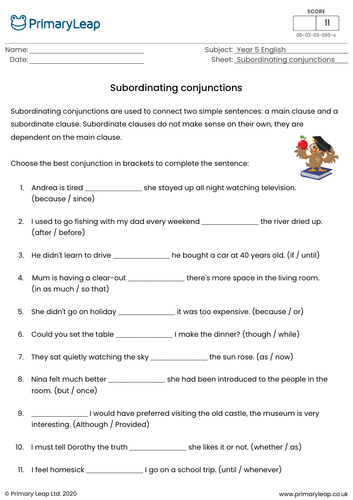560Uploads
454k+Views
210k+Downloads
All resources

KS2 English resource - Use of the hyphen
This KS2 English resource was created by Primary Leap
The symbol (-) is called a hyphen in the English language. A hyphen is a short horizontal line used to link words together. Students read through sentences and write the word that is missing a hyphen.

KS2 Creative writing activity: Back To School - What If...?
A fun creative writing worksheet to get kids thinking! Students imagine it is the first day of school and answer the ‘what if’ questions.
This creative writing resource was created by Lauren Savage

KS2 English - Possessive apostrophe
Apostrophes can be used to show that something belongs to something or someone else. Example: The bear’s paws were big. This English resource asks students to underline the possessive noun in each sentence.
Created by Lauren Savage

KS2 English - Subordinating conjunctions
Subordinating conjunctions are used to connect two simple sentences: a main clause and a subordinate clause. Subordinate clauses do not make sense on their own, they are dependent on the main clause. This English activity asks students to choose the best conjunction in brackets to complete the sentences.
Resource created by Lauren Savage

KS2 English - Coordinating conjunctions
Coordinating conjunctions are used to connect sentences, words and phrases. They act as a kind of glue, linking the text together to help the sentences flow smoothly. This English resource asks students to choose the best conjunction in brackets to complete the sentences.
Worksheet created by Primary Leap

Active or passive?
An active voice is when the subject of the sentence is performing the act. A passive voice is when the subject of the sentence is having something done to it by somebody else. Often the word ‘by’ is used, but not always. This English worksheet asks students to write ‘active’ or ‘passive’ after each sentence.
This worksheet was created by Lauren Savage

Relative clauses
Relative clauses are used to connect sentences. We use relative clauses to give additional information about something without starting a new sentence. The most common relative pronouns are: who, whom, whose, which and that. This English resource asks students to choose the best relative pronoun to complete the sentences.
This worksheet was created by Lauren Savage

Verb prefixes - de and re
A prefix is a group of letters added before a word to alter its meaning. The prefix ‘de’ is used to reverse the verb’s actions. It can also mean ‘down’ such as in the words decrease or decline. The prefix ‘re’ means to do again. This English resource asks students to choose the correct word to complete the sentence.
This worksheet was created by Lauren Savage

Verb prefixes - dis and mis
A prefix is a group of letters added before a word to alter its meaning. The prefix ‘dis’ is generally used to make a word negative. The prefix ‘mis’ means badly, wrongly or incorrectly. This English resource asks students to choose the correct word to complete the sentence.
This worksheet was created by Lauren Savage

Auxiliary verbs
Auxiliary verbs, or helping verbs, add meaning to the main verb of the sentence. This literacy resource asks students to complete sentences by adding auxiliary verbs.
This worksheet was created by Lauren Savage

Alliteration - Animal theme
This animal-themed literacy resource asks students to think of adjectives to create alliterations. For example: curious cat
This English worksheet was created by Lauren Savage

Alliterations - Adjectives
This literacy resource asks students to think of adjectives to create alliterations. For example: blue balloons. Created by Primary Leap

Coronavirus - Global Solutions
This worksheet was created by Lauren Savage @ Primary Leap
Students are asked to take a look at some of the solutions to try and stop the spread of the coronavirus. What do they think are the most effective and why? Write down the advantages and disadvantages of each solution.

Coronavirus Word Search Activity
This simple word search can be used to support teaching students about coronavirus. This worksheet was created by Lauren Savage @ Primary Leap

International Women's Day Word Scramble
International Women’s Day (IWD) is a global event that takes place on 8 March. It is a day to celebrate women’s achievements in a wide number of areas while calling for gender equality. Students are asked to rearrange the letters to find the International Women’s Day words. This worksheet was created by Lauren Savage @ Primary Leap

International Women's Day Word Search
International Women’s Day (IWD) is a global event that takes place on 8 March. It is a day to celebrate women’s achievements in a wide number of areas while calling for gender equality. Students are asked to find the words associated with International Women’s Day hidden in the puzzle. This resource was created by Primary Leap

International Women's Day - Malala Yousafzai
Students are asked to read through the biography of Malala Yousafzai and write a letter to her explaining what they admire about her and how she inspires them.
This worksheet was created by Lauren Savage @ Primary Leap

International Women's Day Fact Sheet
Kids learn some interesting facts about International Women’s Day, the main aims of the event, when the day was officially adopted and interesting statistics.
This worksheet was created by Lauren Savage @ Primary Leap

International Women's Day - Women in History
International Women’s Day is celebrated every year on 8 March. It is a day to celebrate women’s accomplishments in a wide number of areas, all around the world. Students read the facts and match each description to the woman that is being described. This worksheet was created by Lauren Savage @ Primary Leap

Iditarod Race Word Scramble
Students rearrange the letters to find the words associated with the most famous sled dog race in the world, the Iditarod Trail Sled Dog Race. This worksheet was created by Lauren Savage @ Primary Leap




















